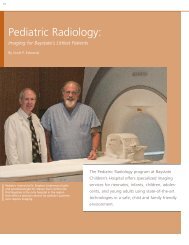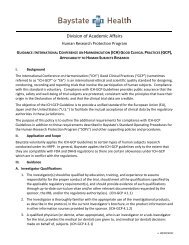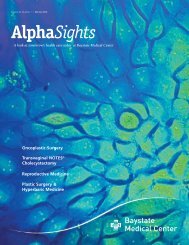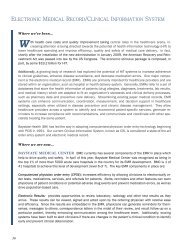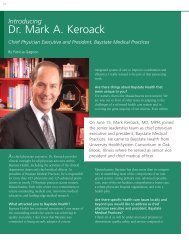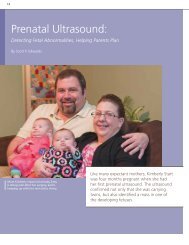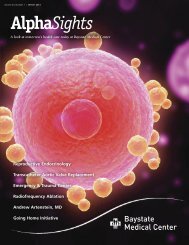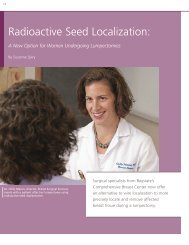Al Pha Sights - Baystate Health
Al Pha Sights - Baystate Health
Al Pha Sights - Baystate Health
Create successful ePaper yourself
Turn your PDF publications into a flip-book with our unique Google optimized e-Paper software.
Volume 20, Number 3 / Fall 2010<br />
<strong>Al</strong>pha<strong>Sights</strong><br />
A look at tomorrow’s health care today at <strong>Baystate</strong> Medical Center<br />
Craniofacial Reconstruction<br />
Stereotactic Body Radiation Therapy<br />
Pediatric Radiology<br />
Radioactive Seed Localization
2<br />
Volume 20 Number 3<br />
Table of<br />
Contents<br />
Cover photo: Breast cancer cells<br />
<strong>Al</strong>pha<strong>Sights</strong><br />
Editors:<br />
Suzanne B. Hendery<br />
Trish Perrault<br />
Managing Editor:<br />
Suzanne Spiry<br />
Writing:<br />
Scott P. Edwards<br />
Suzanne Spiry<br />
Design:<br />
Karen Beckstead<br />
Photography:<br />
Todd Lajoie<br />
Kent Spiry<br />
Chris Szarek<br />
Printing:<br />
Andrews Connecticut<br />
Read current and archived issues of <strong>Al</strong>pha<strong>Sights</strong><br />
magazine online at baystatehealth.org/alphasights.<br />
2<br />
Craniofacial Reconstruction<br />
A successful collaboration between<br />
plastic surgery, neurosurgery, and<br />
other specialties allows children with<br />
craniosynotosis and other anomalies<br />
to benefit from simultaneous reconstruction<br />
of the head and face.<br />
2 6<br />
10 14<br />
6<br />
Stereotactic Body Radiation<br />
Therapy<br />
A new technology with roots in treating<br />
brain cancer now offers an avenue of<br />
hope for patients with inoperable but<br />
early-stage lung cancer.<br />
10<br />
Pediatric Radiology<br />
<strong>Baystate</strong> Children’s Hospital offers<br />
specialized imaging services for<br />
neonates, infants, children, adolescents,<br />
and young adults that are supervised,<br />
performed, and interpreted by<br />
radiologists with subspecialty training.<br />
14<br />
Radioactive Seed Localization<br />
Surgical specialists from <strong>Baystate</strong>’s<br />
Comprehensive Breast Center now<br />
offer an alternative to wire localization<br />
to more precisely locate and remove<br />
affected breast tissue during a<br />
lumpectomy.<br />
17<br />
Welcome New Physicians<br />
22<br />
Honors & Announcements<br />
24<br />
Continuing Education<br />
Calendar<br />
Medical & Nursing Positions<br />
Published by the Marketing & Communications Department, <strong>Baystate</strong> <strong>Health</strong>, Springfield, Massachusetts.<br />
Editorial offices are at 280 Chestnut Street, Springfield, MA 01199. Telephone: 413-794-7652.<br />
Submit article suggestions and address all communications to the Editors.<br />
This publication was developed for the medical staff and friends of <strong>Baystate</strong> <strong>Health</strong>.
Collaboration<br />
Forward<br />
<strong>Baystate</strong> <strong>Health</strong>’s Operating Principles<br />
Trust • Respect • Integrity<br />
Collaboration • Communication<br />
A<br />
moves us<br />
t <strong>Baystate</strong> <strong>Health</strong>, we use a series of five operating<br />
principles to guide how we work, the decisions we<br />
make, and the care we provide. When reviewing this<br />
issue of <strong>Al</strong>pha<strong>Sights</strong>, it occurred to me that the articles<br />
truly reflect one of these key principles: collaboration.<br />
A decade ago, programs described as “multidisciplinary”<br />
were the exception rather than the rule. Patients<br />
had to travel from one hospital department to another<br />
to get opinions from different specialists for a single<br />
condition. Today, our teams of medical experts work<br />
across specialty lines, benefiting not only patients, but<br />
the entire scope of medicine.<br />
Inside this issue, you’ll read how breast surgeons, radiation<br />
oncologists, radiologists, and medical physicists<br />
from the <strong>Baystate</strong> Regional Cancer Program partner to<br />
offer a new option for breast cancer localization for<br />
lumpectomies. You’ll learn how plastic surgeons, neurosurgeons,<br />
pediatric intensivists, geneticists, and pediatricians<br />
at <strong>Baystate</strong> Children’s Hospital are revolutionizing<br />
pediatric craniofacial reconstruction. You’ll see pediatric<br />
radiologists, pediatric intensivists, pediatric anesthetists,<br />
and maternal fetal medicine specialists collabo-<br />
rate to provide imaging services to babies and children<br />
of all ages, even in utero. And you will read how radiation<br />
oncologists, thoracic surgeons, oncologists, and<br />
other specialists combine their talents to offer a new<br />
treatment for certain types of cancer.<br />
Collaboration such as this is what drives us forward,<br />
and it extends far beyond clinicians partnering with<br />
other clinicians. As a health system, we collaborate with<br />
our patients, their families, and our community, with<br />
referring providers and community agencies, with local,<br />
regional, and national government leaders, business<br />
leaders and other health care and educational institutions.<br />
The list goes on. And at the core of all of our<br />
collaborative efforts is the patient and our mission “to<br />
improve the health of the people in our communities<br />
every day, with quality and compassion.”<br />
Sincerely,<br />
Mark R. Tolosky, J.D., FACHE<br />
President & Chief Executive Officer<br />
<strong>Baystate</strong> <strong>Health</strong>
2<br />
Craniofacial<br />
Reconstruction<br />
Restoring Appearance for Children<br />
with Facial and Skull Deformities<br />
By Scott P. Edwards<br />
Cassidy is a vibrant, energetic 18-month-old.<br />
Her life, however, didn’t start out that way.
C<br />
assidy and her fraternal twin brother, Killian, were<br />
born two months premature. While Killian went home<br />
soon after delivery, Cassidy spent 28 days in the<br />
Neonatal Intensive Care Unit (NICU) at <strong>Baystate</strong><br />
Children’s Hospital due to low birth weight, failure to<br />
thrive, reflux, and a bowel infection. At two weeks of<br />
age, Cassidy’s doctors diagnosed her with a unilateral<br />
coronal craniosynotosis.<br />
With craniosynotosis, the fibrous sutures in the skull<br />
close prematurely, forming a solid skull and causing<br />
problems with brain and skull growth. Intracranial<br />
pressure increases and the skull and facial bones form<br />
abnormally and asymmetrically. This condition occurs<br />
in about 1 out of 2,200 births.<br />
In Cassidy’s case, a portion of the front of her skull was<br />
misshapen by the craniosynotosis and her eye sockets<br />
were sunken. But using advanced surgical techniques<br />
beginning with Dr. Paul Tessier in France and developed<br />
over the last 50 years, surgeons at <strong>Baystate</strong><br />
Medical Center were able to reshape her skull and<br />
advance her orbital bones to give her face and head a<br />
near-normal appearance.<br />
“The waiting and wondering were the worst,” says<br />
Cassidy’s mom, Sarah Leshure, of the weeks and<br />
months following the surgery, “but there have been no<br />
other medical concerns. She’s doing well.”<br />
Comprehensive Program<br />
Craniofacial reconstruction surgery like Cassidy’s is not<br />
new, says Joseph Shin, MD, chief of Plastic Surgery at<br />
<strong>Baystate</strong>, who performed the procedure on Cassidy,<br />
along with <strong>Baystate</strong> neurosurgeon Robert Schapiro, MD.<br />
“However, the idea that we could do both the head and<br />
face simultaneously was quite revolutionary,” says Dr.<br />
Shin.<br />
<strong>Al</strong>ong with pediatricians, geneticists, pediatric intensivists,<br />
plastic surgeons, and neurosurgeons, Drs. Shin<br />
and Schapiro developed the craniofacial reconstruction<br />
surgery program at <strong>Baystate</strong> two years ago, in collabora-<br />
tion with Shriners Hospital for Children in Springfield,<br />
which specializes in cleft lip and palate repairs.<br />
“Our goal,” says Dr. Shin, “is to provide holistic care to<br />
our patients and their families.” That care includes a<br />
team of social workers and mental health specialists to<br />
help deal with any psychological issues confronting<br />
patients and families.<br />
The Procedure<br />
The surgical procedure typically involves opening the<br />
entire skull, peeling back the skin to expose the skull<br />
and facial bones, cutting and reshaping the bones, and<br />
inserting resorbable plates and screws to hold the<br />
reshaped bones together.<br />
Drs. Joseph Shin (right) and Robert Schapiro (left) agree that<br />
coordination between the plastic surgeon and neurosurgeon<br />
is essential for successful craniofacial reconstruction.<br />
3
4<br />
Coordination between the plastic surgeon and neurosurgeon<br />
is essential for successful craniofacial reconstruction.<br />
The plastic surgeon’s role is to reshape the<br />
facial deformities, including restoring the function of<br />
“The idea that we could do<br />
both the head and face<br />
simultaneously was<br />
quite revolutionary.”<br />
the patient’s mouth and jaw, as well as improving his or<br />
her appearance. The neurosurgeon focuses on assessing<br />
the patient’s brain function and ensuring that enough of<br />
the skull is preserved to protect the brain as it grows,<br />
while safeguarding the brain, spinal cord, eyes, and<br />
other sensory organs during the procedure. The surgery<br />
is challenging, often taking eight to ten hours to complete,<br />
says Dr. Shin.<br />
Children who have craniofacial reconstruction surgery<br />
typically recover in the Pediatric Intensive Care Unit at<br />
<strong>Baystate</strong> Children’s Hospital for one to three days of<br />
close monitoring. They then transfer to the general<br />
medical/surgical pediatric unit for a few days before<br />
going home. Some children, depending on the severity<br />
of their deformities or if they are syndromic, require<br />
additional surgery.<br />
The surgery can also benefit patients with relatively rare<br />
developmental anomalies such as Crouzon Syndrome<br />
and Apert Syndrome, which have similar features as<br />
craniosynotosis, including misshapen heads and a<br />
sunken-in appearance to the face, as well as breathing<br />
difficulties and malpositioned teeth caused by deformed<br />
facial bones. Craniofacial reconstruction is also used following<br />
the removal of tumors from the head and face.
Dr. Shin, who as the former director of the Yale<br />
Craniofacial Surgery Center has been performing such<br />
craniofacial surgery for more than a decade, says craniofacial<br />
reconstruction is typically performed on young<br />
children–ideally before they are four months<br />
old–because it is easier to cut and manipulate their<br />
softer bones. By age three, nearly 85 percent of the<br />
brain has developed, says Dr. Schapiro, but the skull is<br />
not well solidified until the teen years and often into<br />
the 20s.<br />
“Once the deformity solidifies,” says Dr. Schapiro, “it’s<br />
difficult to address with surgery.” Cassidy was originally<br />
scheduled for surgery at age five months; however,<br />
because of her difficulty gaining weight, the procedure<br />
was postponed until she was eight months old.<br />
Outcomes<br />
Outcomes at <strong>Baystate</strong>, say Drs. Shin and Schapiro, are<br />
so far “terrific,” adding that the <strong>Baystate</strong> surgical team<br />
Mom Sarah Leshure reports that<br />
both Cassidy and Killian are now<br />
happy and energetic toddlers.<br />
Refer a Patient<br />
<strong>Baystate</strong> Plastic Surgery<br />
2 Medical Center Drive, Suite 309<br />
Springfield, Massachusetts<br />
413-794-5363<br />
provides the best framework for ensuring the safest procedures<br />
with the best outcomes. “The best outcome,”<br />
says Dr. Shin, “is restoration of the shape of the skull<br />
and face as best we can for that particular patient.”<br />
Children do better following facial reconstruction surgery<br />
than adults, who typically take longer to recover.<br />
“Children are so resilient,” says Dr. Shin, “that their<br />
recovery time is relatively fast.”<br />
Cassidy is a case in point, as she and Killian tromp<br />
around a <strong>Baystate</strong> exam room during an interview<br />
session with her parents and surgeons. She’s also taller<br />
than her brother now, an encouraging sign. “After her<br />
surgery,” says her mother, “she’s happier, more interested<br />
in things, and gaining weight.”<br />
5
6<br />
Stereotactic Body<br />
Radiation Therapy:<br />
A New Option When Few Exist<br />
By Scott P. Edwards<br />
Radiation oncologist Dr. Michael Yunes (left) works<br />
with Dr. Gary Hochheiser (right), chief of thoracic<br />
surgery, to identify non-surgical candidates who<br />
would benefit from SBRT.<br />
A new technology with roots in treating<br />
brain cancer now offers an avenue of hope<br />
for patients with inoperable but early-stage<br />
(stage I and stage II) lung cancer.
F<br />
or many patients with early-stage lung cancer, the<br />
standard treatment–surgical removal of the tumor–is<br />
not an option because coexisting conditions like<br />
emphysema or heart disease make the surgery too risky.<br />
However, the alternatives available to these patients,<br />
including conventional radiation therapy and observation<br />
with no treatment, are not ideal. Conventional<br />
radiation therapy fails to control primary lung tumors<br />
in up to 70 percent of patients, and more than half will<br />
die from disease progression during observation, and<br />
may not be tolerated in patients with poor lung<br />
function.<br />
Stereotactic body radiation therapy, or SBRT, allows<br />
radiation oncologists specialized in the technique to<br />
safely deliver precisely targeted high doses of radiation<br />
through multiple beam angles to a tumor, while at the<br />
same time minimizing radiation damage to adjacent<br />
normal tissue.<br />
“SBRT gives patients an option outside of traditional<br />
approaches, like surgery and conventional radiation<br />
therapy, for certain cancers,” says Michael Yunes, MD,<br />
director of the Stereotactic Radiosurgery Program of<br />
the <strong>Baystate</strong> Regional Cancer Program. “It’s an option<br />
for many of those who have no other option or who<br />
choose not to have surgery, which is the standard<br />
of care.”<br />
Ensuring Accuracy<br />
SBRT combines the best elements of other forms of<br />
radiation therapy, including the use of multiple radiation<br />
beams to attack a tumor, advanced imaging techniques<br />
to target the tumor, and 4-D (the fourth dimension<br />
is time) imaging for motion control. While the<br />
technique has been used for years to treat intracranial<br />
lesions (<strong>Baystate</strong> began offering stereotactic radiosurgery<br />
for brain tumors in September 2007), clinicians only<br />
recently began using it to treat cancer outside of the<br />
brain, primarily in the lung, liver, and spine, and for<br />
metastatic disease.<br />
Dr. Yunes says SBRT differs from stereotactic radiosurgery<br />
for brain lesions in several key areas. When<br />
treating a patient with a brain tumor, a rigid frame is<br />
attached to the patient’s head to ensure there is no<br />
movement during treatment. This type of stabilization<br />
system is not suitable for procedures in the chest and<br />
abdomen, because of the patient’s normal respiratory<br />
cycle and all the moving parts in these areas of the<br />
body. Instead, SBRT uses a vacuum technology called<br />
BodyFix to immobilize patients.<br />
“We can offer tighter accuracy<br />
in quality assurance,<br />
planning, and treatment with SBRT.”<br />
BodyFix is like a “big blue beanbag,” says Dr. Yunes.<br />
The patient lies down on a soft cushion and air is<br />
sucked out of it so that it conforms to the patient’s<br />
body. A plastic cover sheet is placed over the patient,<br />
and the air is sucked out of that, as well. This creates a<br />
“comfortable, stable, and precise mold of the patient’s<br />
position for up to six weeks,” according to BodyFix<br />
manufacturer Elekta.<br />
“It’s rather like the patient is vacuum-sealed into it,”<br />
says Dr. Yunes. Patients can’t shift positions once they<br />
are in the BodyFix cushions.”<br />
While the BodyFix system immobilizes the patient, the<br />
overriding technology in SBRT is ExacTrac, a highly<br />
precise radiation delivery system that allows radiation<br />
oncologists to target tumors with millimeter accuracy.<br />
Implantable markers, called fiducials, can be placed in<br />
or adjacent to the tumor to track the tumor during<br />
treatment planning, set-up, and treatment. ExacTrac<br />
uses dual X-ray machines mounted in the floor below<br />
7
8<br />
the linear accelerator that produce X-ray images that<br />
crisscross the body to the digital imaging panels<br />
mounted on the ceiling. This allows more accurate<br />
targeting of the tumor.<br />
“Accuracy is key,” says Dr. Yunes. “We can offer much<br />
tighter accuracy in quality assurance, planning, and<br />
treatment with SBRT.”<br />
This accuracy has great benefit for the patient. Not<br />
only does the tumor receive a very high dose of<br />
radiation, but healthy surrounding tissue is spared.<br />
And, unlike conventional radiation therapy that is<br />
typically delivered in 30 to 40 treatments, SBRT can<br />
be completed in anywhere from one to five sessions.<br />
Dr. Yunes notes the typical treatment for early-stage<br />
lung cancer is three sessions.<br />
Team Approach<br />
SBRT requires the collaboration of several disciplines.<br />
Dr. Yunes works with Gary Hochheiser, MD, chief of<br />
thoracic surgery at <strong>Baystate</strong> Medical Center, to identify<br />
non-surgical candidates who would benefit from SBRT.<br />
There are several options available for treating lung cancer<br />
patients, including surgery, radiation therapy,<br />
chemotherapy, cryoablation, and radiofrequency ablation.<br />
Because these treatment options are spread across<br />
multiple specialties, “you can’t treat the patient alone,”<br />
says Dr. Hochheiser. “You need a team of different disciplines<br />
to determine the best option for each individual<br />
patient.”<br />
Wilson Mertens, MD, medical director of the <strong>Baystate</strong><br />
Regional Cancer Program, says this multidisciplinary<br />
approach also leads to greater efficiency. “Involving the<br />
Left: SBRT uses a vacuum technology called BodyFix<br />
to immobilize patients.<br />
Above: ExacTrac allows radiation oncologists to target<br />
tumors with millimeter accuracy.
key treating specialties in treatment plan development<br />
results in enhanced communication between health<br />
care professionals, and expands the menu of treatment<br />
options we can offer individual patients,” he says. “Our<br />
program’s approach to SBRT ensures that the thoracic<br />
surgeon and radiation oncologist work together on the<br />
treatment plan, leading to appropriate patient selection<br />
and more precise therapy.”<br />
Promising Results<br />
Dr. Yunes says that short-term results at <strong>Baystate</strong> have<br />
been promising, with excellent tolerance and few side<br />
effects, but it’s too early to tell about long-term outcomes.<br />
As of October, 30 patients had been treated at<br />
<strong>Baystate</strong> with SBRT, and Dr. Yunes describes the results<br />
as “extremely encouraging.”<br />
In addition, a recent preliminary study in the Journal of<br />
the American Medical Association shows how good outcomes<br />
can be with this treatment.<br />
The study, conducted at the University of Texas<br />
Southwestern Medical Center in Dallas, found that<br />
nearly 56 percent of patients with early-stage lung<br />
cancer who underwent SBRT were still alive three<br />
years after treatment, and that the rate of tumor<br />
control was more than double that found with<br />
conventional radiation therapy.<br />
“The results of this study,” says Dr. Hochheiser, “are<br />
really much better than I would have thought, given<br />
what we know about treating lung cancer.”<br />
Adding Versatility<br />
While 50 percent of the patients treated with SBRT at<br />
<strong>Baystate</strong> have lung cancer, radiation oncologists are also<br />
using it to treat a variety of cancers, says Dr. Yunes,<br />
including liver, spinal cord tumors, and recurrent head<br />
and neck cancers. Other medical centers have used it to<br />
treat pancreatic, kidney, retroperitoneal, and prostate<br />
tumors.<br />
Dr. Mertens says SBRT adds even more to the comprehensive<br />
cancer care services offered at <strong>Baystate</strong> and particularly<br />
benefits those who would otherwise have to<br />
travel long distances for SBRT treatment.<br />
“This adds to the versatility of <strong>Baystate</strong>’s cancer services,”<br />
agrees Dr. Hochheiser. “It’s another tool in our<br />
armamentarium to care for cancer patients, as opposed<br />
to saying ‘we can’t help you’ or ‘we can help you, but<br />
there will be significant side effects.’”<br />
Refer a Patient<br />
<strong>Baystate</strong> Thoracic Surgery<br />
2 Medical Center Drive, Suite 306<br />
Springfield, Massachusetts<br />
413-794-8050<br />
9
10<br />
Pediatric Radiology:<br />
Imaging for <strong>Baystate</strong>’s Littlest Patients<br />
By Scott P. Edwards<br />
Pediatric intensivist Dr. Stephen Lieberman (right)<br />
and anesthesiologist Dr. Steven Dunn (left) note<br />
that <strong>Baystate</strong> is the only hospital in the region<br />
that offers a sedation service for pediatric patients<br />
who require imaging.<br />
The Pediatric Radiology program at <strong>Baystate</strong><br />
Children’s Hospital offers specialized imaging<br />
services for neonates, infants, children, adolescents,<br />
and young adults using state-of-the-art<br />
technologies in a safe, child and family friendly<br />
environment.
T<br />
he program offers the full gamut of imaging studies and<br />
image guided pediatric care including standard X-rays,<br />
fluoroscopy, ultrasound, CT, and MRI. The studies are<br />
supervised, performed, and interpreted by radiologists<br />
with subspecialty training.<br />
Pediatric radiologists are experts in selecting the best<br />
imaging techniques to diagnose medical and surgical<br />
problems in infants and children. They are available as<br />
consultants to guide the imaging algorithm and recommend<br />
non-radiation examinations, when appropriate.<br />
The pediatric radiologists ensure that the testing is<br />
performed properly and safely so that an accurate<br />
diagnosis can be made.<br />
<strong>Baystate</strong>’s Pediatric Radiology program is a subspecialty<br />
within the Department of Radiology. The bright colors and<br />
toys in the pediatric waiting room provide comfort for<br />
children and their families. The exam rooms are staffed by<br />
a dedicated group of radiology technologists who create a<br />
safe, family friendly environment. Nurses and Child Life<br />
specialists are also key members of the team. No other<br />
hospital in the region provides this level and range of<br />
subspecialized care. Three unique initiatives make<br />
<strong>Baystate</strong>’s Pediatric Radiology program further stand out:<br />
sedation, fetal MRI, and “image gently.”<br />
Sedation<br />
Because most children, especially very young ones, are<br />
unable to hold still for the 15 to 90 minutes it takes to<br />
complete an MRI and other imaging studies, many of<br />
them receive moderate sedation to decrease their movement<br />
so the scan can be completed.<br />
A combined program to support Pediatric Radiology<br />
services was developed with <strong>Baystate</strong>’s pediatric anesthesiologists<br />
and pediatric intensivists. The pediatric anesthesiologists<br />
and nurse anesthetists from the Department of<br />
Anesthesiology manage infants and children with complex<br />
medical problems and the need for general anesthesia to<br />
complete their MRI studies. Cases requiring moderate<br />
sedation are supported by the pediatric intensivists who<br />
are experienced with the medications used for sedation<br />
as they are widely used in <strong>Baystate</strong>’s Pediatric Intensive<br />
Care Unit.<br />
“The program started when, rather quickly, there became<br />
an increasing number of children who required some type<br />
of medication for a variety of imaging procedures,” says<br />
Stephen Lieberman, MD, the pediatric intensivist who<br />
started the program. Between 800 to 900 procedures will<br />
be performed this year at <strong>Baystate</strong> Children’s Hospital.<br />
While many children undergoing imaging studies can be<br />
sedated, others need to be completely unconscious in<br />
order to remain still. “Similar to when anyone has surgery,<br />
we have a system in place to screen pediatric patients and<br />
prepare them for anesthesia,” says Steven Dunn, MD,<br />
interim chair of <strong>Baystate</strong>’s Department of Anesthesiology.<br />
“Many other places don’t offer this service because it is<br />
labor intensive, and they might not have enough anesthesiologists<br />
who are completely comfortable caring for small<br />
children.”<br />
Pediatric intensivists provide moderate sedation for a variety<br />
of procedures, including interventional radiology<br />
(PICC lines, feeding tubes, arteriograms); CT scan-guided<br />
removal of fluid from the chest, abdomen, and surrounding<br />
the heart; MRIs; ultrasound-guided biopsies of the<br />
kidney and liver; gastrointestinal endoscopies, bronchoscopies,<br />
spinal taps, and bone marrow biopsies; and voiding<br />
cystourethrograms.<br />
Pediatric radiologists (left to right) Drs. Stephen O’Connor,<br />
Tara Catanzano, and Stanley Polansky offer comprehensive<br />
imaging studies and image guided pediatric care including<br />
standard X-rays, fluoroscopy, ultrasound, CT, and MRI.<br />
11
12<br />
In addition to Dr. Lieberman, pediatric intensivists<br />
Christine McKiernan, MD, and Michael Canarie, MD,<br />
are part of the program, as well as Rebecca Blanchard,<br />
RN, who assists with the large volume of MRIs that<br />
require sedation.<br />
“We are the only hospital in the area to offer this service<br />
because <strong>Baystate</strong> Children’s Hospital is the only institution<br />
in Western Massachusetts with the expertise to do<br />
it safely, especially the nursing personnel who place the<br />
IVs and monitor the children,” says Dr. Lieberman.<br />
Fetal MRI<br />
<strong>Baystate</strong> Medical Center is also the only institution in<br />
Western Massachusetts that offers fetal MRI. Stephen<br />
O’Connor, MD, pediatric radiologist, has primary<br />
responsibility for this service. “Fetal MRI is a powerful<br />
tool that can expand and confirm information obtained<br />
from the high quality ultrasounds performed by our<br />
colleagues in Maternal Fetal Medicine. It allows us to<br />
further investigate potentially serious fetal anomalies in<br />
the brain, spine, thorax, and abdomen without the use<br />
of sedation or radiation.”<br />
Unique to fetal MRIs, Dr. O’Connor says he actually sits<br />
at the console with the MRI technologist so that the<br />
images can be obtained quickly to account for fetal<br />
motion. “This makes it especially challenging,” he says.<br />
“When we see certain anomalies on ultrasound in either<br />
the fetus or the mother,” says <strong>Baystate</strong> Maternal/Fetal<br />
Medicine specialist Fadi Bsat, MD, “MRI can help. It<br />
can also be helpful in conditions that could change the<br />
management of the pregnancy or in preparation for<br />
possible complications at delivery.”<br />
Dr. Bsat says fetal MRIs are most often used at <strong>Baystate</strong><br />
for fetal central nervous system abnormalities or fetal<br />
chest or neck masses. For example, ultrasound may not<br />
be able to determine if a baby with a chest mass will be<br />
able to breathe after delivery, but MRI can tell physicians<br />
if the baby’s lungs may be compromised and intubation<br />
or other interventions are required at delivery.<br />
Dr. O’Connor adds, “The push to add fetal MRI at<br />
<strong>Baystate</strong> came from a group of specialists including<br />
pediatric surgeons, geneticists, neonatologists, and<br />
maternal fetal specialists, who approached us because at<br />
the time, the closest place offering fetal MRI was in<br />
Boston. Traveling that far was often a hardship for<br />
patients, so offering this subspecialty locally is a<br />
tremendous benefit for patients, making it much more<br />
likely they’ll stay with <strong>Baystate</strong> for the remainder of<br />
their pre- and post-natal care. It also offers positive<br />
implications for our graduate medical education programs<br />
in obstetrics/gynecology, surgery, pediatrics, anesthesiology,<br />
and radiology.”<br />
Maternal Fetal Medicine specialist<br />
Dr. Fadi Bsat says fetal MRIs are<br />
most often used at <strong>Baystate</strong> for<br />
fetal central nervous system<br />
abnormalities or fetal chest or<br />
neck masses.
MRI is also used for the health of the mother, especially<br />
in trauma cases in which the mother’s abdomen or<br />
pelvis is involved and for whom X-ray or CT scan may<br />
be associated with some fetal risks. It can also help<br />
detect problems such as placenta accreta, a severe<br />
obstetric complication involving strong attachment of<br />
the placenta to the uterine wall, which can cause severe<br />
bleeding with detachment.<br />
Image Gently<br />
Radiation exposure, including medical radiation, is a<br />
concern for both adults and children. This is particularly<br />
important in children since their tissues are more<br />
radiosensitive. Children have a longer lifetime in which<br />
to manifest radiation-induced injury. Each examination<br />
should be considered cumulative and therefore more<br />
likely to result in adverse health effects.<br />
<strong>Baystate</strong>’s Pediatric Radiology program has been active<br />
for years in efforts to reduce medical radiation in children.<br />
This goal is fostered through a long-term involvement<br />
in the Society for Pediatric Radiology and, since<br />
2006, in the <strong>Al</strong>liance for Radiation Safety in Pediatric<br />
Imaging. <strong>Baystate</strong>’s program has participated in the<br />
national “image gently” campaign since its inception.<br />
The motivating principle is to change medical and radiology<br />
practice by increasing awareness of the opportunities<br />
to lower radiation doses when imaging children.<br />
“At <strong>Baystate</strong>, we respect the fact that children are more<br />
susceptible to radiation problems than adults,” says<br />
Stanley Polansky, MD, chief of Pediatric Radiology, “so<br />
we use the lowest possible levels of radiation. We took<br />
the pledge to ‘image gently,’ and we adhere to the principles<br />
expounded by the <strong>Al</strong>liance.”<br />
With the help of medical physicist M. Terry LaFrance,<br />
<strong>Baystate</strong>’s pediatric radiologists follow the ALARA (As<br />
Low As Reasonably Achievable) principle of radiation<br />
safety, scaling back radiation doses for children.<br />
“This is a dynamic process with constant monitoring of<br />
techniques to further cut back radiation exposure, particularly<br />
in CT,” says Dr. Polansky. “In general, properly<br />
performed CT examinations of children should expose<br />
a child to much lower exposures than those for the<br />
same procedure on an adult. The potential benefit from<br />
an indicated CT examination is clinically recognized<br />
and documented and is far greater than the potential<br />
cancer risk.”<br />
In addition, Dr. Polansky and his colleagues Drs.<br />
Stephen O’Connor and Tara Catanzano, serve as<br />
resources for referring physicians and patients’ families.<br />
They offer advice about what imaging procedures are<br />
appropriate and what imaging alternatives are available<br />
that do not use radiation.<br />
“The role of the pediatric radiologist is multifold,” says<br />
Dr. Polansky. “It is to understand radiation doses;<br />
review requests for higher dose studies; discuss cases<br />
with clinicians; use appropriate technical factors; help<br />
spread current knowledge about radiation doses; train<br />
medical students, residents, and radiology technologists;<br />
educate health care providers; and participate in<br />
Professional Quality Improvement programs.”<br />
“Our pediatric radiologists do not fit the profile of a<br />
typical ‘adult’ radiologist,” says Laurie Gianturco, MD,<br />
chair of Radiology at <strong>Baystate</strong> Medical Center. “They<br />
spend a lot of time working closely with patients and<br />
their families, and the pediatricians and surgeons at<br />
<strong>Baystate</strong> and in the community.”<br />
Dr. Polansky concludes, “When a child is referred to<br />
us, their family can feel secure that they are going to<br />
a center that provides special attention to children,<br />
offers a safe and friendly environment, accomplishes<br />
imaging exams with high degrees of success, and<br />
adheres to principles for using the least amount<br />
of radiation possible.”<br />
Refer a Patient<br />
<strong>Baystate</strong> Children’s Hospital<br />
759 Chestnut Street<br />
Springfield, Massachusetts<br />
413-794-2222<br />
13
14<br />
Radioactive Seed Localization:<br />
A New Option for Women Undergoing Lumpectomies<br />
By Suzanne Spiry<br />
Dr. Holly Mason, director, Breast Surgical Services,<br />
meets with a patient after her lumpectomy using<br />
radioactive seed implantation.<br />
Surgical specialists from <strong>Baystate</strong>’s<br />
Comprehensive Breast Center now offer<br />
an alternative to wire localization to more<br />
precisely locate and remove affected<br />
breast tissue during a lumpectomy.
“A<br />
s the technology behind screening mammograms<br />
has become more refined,” says Grace Makari-Judson,<br />
MD, medical director, Comprehensive Breast Center,<br />
“we are able to detect a greater number of breast<br />
abnormalities and cancers before they can be felt with<br />
a physical exam. While this allows us to catch problems<br />
earlier than ever, it also makes the affected tissue<br />
more challenging to precisely locate and remove.”<br />
For women with breast cancer who will undergo a<br />
lumpectomy, the wire-localization procedure (WLP)<br />
has long been the standard. With this protocol, the<br />
radiologist places a guide-wire into the area of concern<br />
in the breast using mammography prior to the<br />
surgery. During the surgery, the surgeon removes the<br />
tissue surrounding the guide-wire and sends it to the<br />
laboratory for biopsy.<br />
“While WLP is very useful, it also presents several<br />
challenges,” says Holly Mason, MD, director, Breast<br />
Surgical Services. Since the guide-wire cannot be<br />
placed into the breast until the day of surgery, scheduling<br />
the surgery is more complicated. The placement<br />
of the wire is very uncomfortable for the patient. The<br />
wire may shift or be dislodged, decreasing the accuracy<br />
of the procedure. The wire is very thin and can be<br />
difficult to feel within the breast tissue, and the location<br />
where the wire exits the skin does not always<br />
reflect the location of the tumor, making incision<br />
planning difficult. Finally, the wire and the mammograms<br />
showing the wire placement provide only a limited<br />
view of the location of the tumor, which can<br />
make removal of the tissue less accurate, potentially<br />
requiring a re-excision.<br />
Radioactive seed localization (RSL) offers a new alternative.<br />
With this procedure, a radiologist places a very<br />
low-energy radioactive seed into the abnormal tissue<br />
or tumor, guided by mammography. During the surgery,<br />
the surgeon uses a handheld Geiger counter to<br />
more precisely identify the location of the tumor. The<br />
Geiger counter also allows the surgeon to obtain a<br />
three dimensional view of the tumor’s location.<br />
RSL offers multiple benefits over WLP. The radiologist<br />
can implant the seed up to a week before the surgery,<br />
thereby making the scheduling process easier and<br />
reducing the wait time for patients. The seed placement<br />
is also better tolerated by patients than the wire.<br />
Dr. Mason is currently the<br />
only surgeon in the region<br />
trained to perform<br />
the radioactive seed<br />
localization procedure.<br />
More importantly, notes Dr. Mason, who is currently<br />
the only surgeon in the region trained to perform the<br />
RSL procedure, RSL provides increased accuracy over<br />
WLP. With RSL, the surgeon knows the precise location<br />
of the tumor and can more accurately plan the<br />
surgical incision. This also reduces the length of the<br />
surgery. In addition, studies show that RSL reduces<br />
the need to have a second surgery due to incomplete<br />
removal of the abnormal tissue.<br />
Seed Implantation<br />
Patients have an appointment at <strong>Baystate</strong>’s Chestnut<br />
Surgery Center up to a week prior to their surgery for<br />
the implantation of the seed. A specially-trained radiologist<br />
performs the seed implantation, assisted by a<br />
mammography technologist.<br />
15
16<br />
The seed placement procedure is very similar to a needle<br />
biopsy procedure. The radiologist injects a local<br />
anesthetic to numb the area before starting the procedure.<br />
Mammography is used to guide placement of<br />
the seed. The seed (Iodine 125 or I-125) is of very<br />
low energy, and its placement is not considered to be<br />
dangerous to the patient.<br />
Studies show that<br />
RSL reduces the need<br />
to have a second surgery<br />
due to incomplete removal of<br />
the abnormal tissue.<br />
On the day of the lumpectomy, the patient arrives<br />
about two hours before the surgery, and receives an IV<br />
with light sedation, and a local anesthetic to numb the<br />
surgical area. After the surgeon removes the abnormal<br />
tissue or tumor along with the radioactive seed, the<br />
incision is closed and bandaged. Once the seed is<br />
removed with the breast tissue, all of the radioactivity<br />
is gone. The patient is able to leave the hospital later<br />
that same day.<br />
Most patients are potential candidates for RSL, with<br />
the exception of women who are pregnant, women<br />
who have implants, or women with lesions close to<br />
the chest wall or skin. While there is likely little risk<br />
to the fetus because of the low energy radiation of the<br />
seed, it is best to avoid any radiation exposure, so<br />
pregnant women are scheduled for the wire-localization<br />
procedure. Women who are breastfeeding are<br />
asked not to nurse while the seed is in place.<br />
“We are very pleased with the results we have seen so<br />
far,” says Dr. Mason. “The seed allows me to be much<br />
more accurate during the surgery while reducing the<br />
amount of time it takes, and the process is smoother<br />
for the patient as well.”<br />
Refer a Patient<br />
<strong>Baystate</strong> Regional Cancer Program<br />
Comprehensive Breast Center<br />
3400 Main Street<br />
Springfield, Massachusetts<br />
413-794-9338
Welcome<br />
New Physicians<br />
<strong>Baystate</strong> Medical Center and<br />
<strong>Baystate</strong> Medical Practices<br />
proudly welcomes the following<br />
physicians to its medical staff.<br />
<strong>Baystate</strong> Heart and<br />
Vascular Program<br />
Laura Feldman, MD<br />
<strong>Baystate</strong> Vascular Services<br />
3500 Main Street, Springfield<br />
413-794-3282<br />
Neurology<br />
Anant Shenoy, MD<br />
<strong>Baystate</strong> Neurology<br />
3300 Main Street, Springfield<br />
413-794-7033<br />
Cardiology<br />
Gregory Valania, MD<br />
<strong>Baystate</strong> Cardiology<br />
3300 Main Street, Springfield<br />
413-794-7246<br />
Hospital Medicine<br />
Aroosa <strong>Al</strong>am, MD<br />
759 Chestnut Street, Springfield<br />
413-794-4320<br />
Gastroenterology<br />
Angelica Chiomo Belo,<br />
MBBS, MD<br />
<strong>Baystate</strong> Gastroenterology<br />
3300 Main Street, Springfield<br />
413-794-7364<br />
Hospital Medicine<br />
17<br />
Sabarish Ram Ayyappan, MD<br />
759 Chestnut Street, Springfield<br />
413-794-4320
18<br />
Welcome New Physicians<br />
Hospital Medicine<br />
Muzzaffar Hussain, MD<br />
759 Chestnut Street, Springfield<br />
413-794-4320<br />
Hospital Medicine<br />
Bharanidhar Chandrasekaran, MD<br />
759 Chestnut Street, Springfield<br />
413-794-4320<br />
Hospital Medicine<br />
Halil Mutlu, MD<br />
759 Chestnut Street, Springfield<br />
413-794-4320<br />
Hospital Medicine<br />
Kyamalya Ismailova, MD<br />
759 Chestnut Street, Springfield<br />
413-794-4320<br />
Hospital Medicine<br />
Nishant Dhungel, MD<br />
759 Chestnut Street, Springfield<br />
413-794-4320<br />
Hospital Medicine<br />
Abhijit Naik, MD<br />
759 Chestnut Street, Springfield<br />
413-794-4320<br />
Hospital Medicine<br />
Puneet Menaria, MD<br />
759 Chestnut Street, Springfield<br />
413-794-4320
Hospital Medicine<br />
Adrianne Seiler, MD<br />
759 Chestnut Street, Springfield<br />
413-794-4320<br />
Hospital Medicine<br />
Gaurav Narula, MD<br />
759 Chestnut Street, Springfield<br />
413-794-4320<br />
Emergency Medicine<br />
Scott Millay, MD<br />
759 Chestnut Street, Springfield<br />
413-794-3343<br />
Hospital Medicine<br />
Kirti Talole, MD<br />
759 Chestnut Street, Springfield<br />
413-794-4320<br />
Hospital Medicine<br />
Phyllis Owusu-Griffin, MD<br />
759 Chestnut Street, Springfield<br />
413-794-4320<br />
Emergency Medicine<br />
Elizabeth Schoenfeld, MD<br />
759 Chestnut Street, Springfield<br />
413-794-3343<br />
Emergency Medicine<br />
Jennifer Cyrkler, MD<br />
759 Chestnut Street, Springfield<br />
413-794-3343<br />
19
20<br />
Surgery<br />
Surgery<br />
Thomas Kaye, MD<br />
<strong>Baystate</strong> Neurosurgery<br />
2 Medical Center Drive, Springfield<br />
413-794-4440<br />
Salman Ahmad<br />
<strong>Baystate</strong> Trauma Services<br />
2 Medical Center Drive, Springfield<br />
413-794-8020<br />
Surgery<br />
Surgery<br />
Ben Schalet, MD<br />
<strong>Baystate</strong> Plastic Surgery<br />
2 Medical Center Drive, Springfield<br />
413-794-5363<br />
Surgery<br />
Jacqueline Lee, MD<br />
<strong>Baystate</strong> Thoracic Surgery<br />
2 Medical Center Drive, Springfield<br />
413-794-8050<br />
Andrew Doben, MD<br />
<strong>Baystate</strong> Trauma Services<br />
2 Medical Center Drive, Springfield<br />
413-794-8020<br />
Surgery<br />
Surgery<br />
Clemons Schirmer, MD<br />
<strong>Baystate</strong> Neurosurgery<br />
2 Medical Center Drive, Springfield<br />
413-794-4440<br />
Pranay Parikh, MD<br />
<strong>Baystate</strong> Plastic Surgery<br />
2 Medical Center Drive, Springfield<br />
413-794-5363
Primary Care<br />
Sharon Wretzel, MD<br />
<strong>Baystate</strong> Mason Square<br />
Neighborhood <strong>Health</strong> Center<br />
11 Wilbraham Road, Springfield<br />
413-794-3710<br />
Primary Care<br />
Gina Luciano, MD<br />
<strong>Baystate</strong> High Street <strong>Health</strong> Center<br />
140 High Street, Springfield<br />
413-794-2511<br />
Psychiatry<br />
Lawrence Peters, MD<br />
<strong>Baystate</strong> Behavioral <strong>Health</strong><br />
3300 Main Street, Springfield<br />
413-794-7035<br />
Psychiatry<br />
Stuart Anfang, MD<br />
<strong>Baystate</strong> Behavioral <strong>Health</strong><br />
3300 Main Street, Springfield<br />
413-794-7035<br />
Welcome New Physicians<br />
Primary Care<br />
Ahmad Waseef, MD<br />
BMP East Longmeadow Adult Medicine<br />
294 N. Main Street, East Longmeadow<br />
413-525-4555<br />
Psychiatry<br />
Cassandra Danielle<br />
Hobgood, MD<br />
<strong>Baystate</strong> Behavioral <strong>Health</strong><br />
3300 Main Street, Springfield<br />
413-794-7035<br />
Physical Medicine & Rehabilitation<br />
Jonathan Richmond, MD<br />
<strong>Baystate</strong> Physical Medicine and Rehabilitation<br />
294 North Main Street, East Longmeadow<br />
413-794-1150<br />
21
22<br />
Honors &<br />
Announcements<br />
Sandra Bellantonio, MD, <strong>Baystate</strong><br />
Geriatric Medicine, was promoted to<br />
chief of Geriatrics and Post Acute<br />
Medicine at <strong>Baystate</strong> Medical Center.<br />
Evan Benjamin, MD, vice<br />
president/chief quality officer for<br />
<strong>Baystate</strong> <strong>Health</strong>, was honored as a<br />
Quality Leader by the Massachusetts<br />
Medical Law Report for “RX for<br />
Excellence,” honoring the best<br />
practices in medicine.<br />
Christine Bryson, DO, a hospitalist at<br />
<strong>Baystate</strong> Medical Center, was inducted<br />
as a “Fellow in Hospital Medicine” by<br />
the Society of Hospital Medicine. This<br />
honor is bestowed on those who have<br />
demonstrated their commitment to<br />
hospital medicine and quality improvement<br />
practices in the hospital setting.<br />
Mark Hirko, MD, chief of Vascular<br />
Surgery at <strong>Baystate</strong>, was appointed to<br />
the editorial board of the Journal of<br />
Vascular Surgery as a section topic<br />
reviewer. He is also on the editorial<br />
board of Current Surgery.<br />
Paul Jodka, MD, Critical Care<br />
Medicine Division, begins a two-year<br />
term on the Palliative and End-of-Life<br />
Care Network Steering Committee in<br />
Vancouver, BC, Canada. He was also<br />
selected for a one-year appointment to<br />
the ACCP’s Ethics Committee.<br />
Sandra Bellantonio, MD<br />
Jeffrey Kaufman, MD, <strong>Baystate</strong><br />
Vascular Services, was reappointed to<br />
the editorial board of the Journal of<br />
Vascular Surgery. He has served on the<br />
board for over a decade.<br />
James Nichols, PhD, <strong>Baystate</strong><br />
Pathology Diagnostic Medicine Services,<br />
received the “Professor <strong>Al</strong>vin Dubin<br />
Award for Outstanding Contributions<br />
to the Profession and the Academy.”<br />
The award recognizes a member of the<br />
National Academy of Clinical Biochemistry<br />
(NACB) who has made noteworthy<br />
advances enhancing the mission and<br />
stature of NACB.<br />
Evan Benjamin, MD<br />
Mark Hirko, MD Paul Jodka, MD<br />
<strong>Baystate</strong> CLINICAL WEB<br />
Christine Bryson, DO<br />
Christopher Otis, MD, director of<br />
Surgical Pathology at <strong>Baystate</strong>, was<br />
appointed to the College of American<br />
Pathologists Cancer Committee. He<br />
also serves as the Cancer Committee’s<br />
Gynecologic Malignancies subcommittee<br />
chair.<br />
Niels Rathlev, MD, chair of the<br />
Department of Emergency Medicine,<br />
was elected to the Board of Directors<br />
and Executive Committee of the<br />
Massachusetts College of Emergency<br />
Physicians.<br />
<strong>Baystate</strong> <strong>Health</strong> is pleased to announce a new way to access your patients’ health information related<br />
to all encounters that occur within any of the <strong>Baystate</strong> <strong>Health</strong> facilities.<br />
<strong>Baystate</strong> Clinical Web is a web-based application that provides real-time simplified viewing of patient<br />
encounter information, clinical data, laboratory, radiology and<br />
pathology results, documents, and reports. Circumventing the need<br />
to login to the <strong>Baystate</strong> network, you can securely log into <strong>Baystate</strong><br />
Clinical Web from any remote site with the single entry of username<br />
and password.<br />
The data are displayed in an intuitive user interface that facilitates<br />
“read-only” review of vital patient information. The data can be<br />
organized and sorted by individual physician, practice group, or<br />
other custom lists. In addition, individual patient names can be<br />
searched and, with the explicit declaration of a clinical<br />
relationship, access can be provided for acute care<br />
purposes, e.g. emergency or inpatient services.<br />
To gain access to <strong>Baystate</strong> Clinical Web, please call the<br />
<strong>Baystate</strong> <strong>Health</strong> Help Desk at 413-794-3000.
Jeffrey Kaufman, MD<br />
John Santoro, MD<br />
James Nichols, PhD<br />
John Santoro, MD, vice chair of the<br />
Department of Emergency Medicine,<br />
was reelected to the Pioneer Valley Red<br />
Cross Board of Directors.<br />
James Stewart, MD, chief of<br />
Hematology/Oncology, received the<br />
“Appreciation Award for Role in<br />
Developing Medical Oncology In-training<br />
Exam” from the American Society<br />
of Clinical Oncology (ASCO) and<br />
Medical Oncology Program Directors.<br />
Dr. Stewart worked with ASCO to generate<br />
enthusiasm for a national exam<br />
for medical oncology fellows. He<br />
chaired the test writing committee for<br />
its first two years and remained on the<br />
committee for two more years.<br />
Winthrop Whitcomb, MD, a hospitalist<br />
and medical director of <strong>Health</strong>care<br />
Quality at <strong>Baystate</strong> Medical Center, was<br />
inducted by the Society of Hospital<br />
Medicine as one of three founding and<br />
inaugural “Masters in Hospital<br />
Medicine” at its annual meeting. They<br />
were honored for their visionary contributions<br />
for improving hospital medicine<br />
and serving as pioneering leaders in this<br />
emerging field. The Masters in Hospital<br />
Medicine represents the highest honor<br />
in hospital medicine. A practicing hospitalist<br />
for 16 years, Dr. Whitcomb also<br />
serves as the physician advisor on<br />
Quality Initiatives for the Society of<br />
Hospital Medicine.<br />
James Stewart, MD<br />
Christopher Otis, MD<br />
Academic<br />
Honors & Updates<br />
<strong>Baystate</strong> Medical Center is the region’s<br />
only academic teaching hospital and<br />
serves as the Western Campus of Tufts<br />
University School of Medicine (TUSM).<br />
Awards<br />
• Carlos Acevedo, MD, a hospitalist at<br />
<strong>Baystate</strong> Medical Center, was<br />
awarded “Teacher of the Year” by<br />
Tufts University School of Medicine<br />
third year medical students, one of<br />
the highest honors in education at<br />
any teaching hospital.<br />
• Julio Martinez-Silvestrini, MD,<br />
<strong>Baystate</strong> Physical Medicine &<br />
Rehabilitation, was selected “Teacher<br />
of the Year” by Tufts University<br />
School of Medicine physical medicine<br />
and rehabilitation (PMR) residents.<br />
Over the last several years, he has<br />
conducted conferences for PMR<br />
residents on selected topics in sports<br />
medicine and musculoskeletal<br />
medicine.<br />
Niels Rathlev, MD<br />
Winthrop Whitcomb, MD<br />
Accreditations<br />
<strong>Baystate</strong>’s Critical Care Medicine<br />
fellowship program was awarded<br />
continued accreditation for the maximum<br />
of five years by the Accreditation<br />
Council for Graduate Medical Education<br />
(ACGME). Mark Tidswell, MD, serves as<br />
the program director.<br />
<strong>Baystate</strong>’s Cardiovascular Disease<br />
fellowship program was awarded<br />
continued accreditation for the maximum<br />
of five years by the ACGME.<br />
Mara Slawsky, MD, serves as the program<br />
director.<br />
23<br />
<strong>Baystate</strong> Medical Center is the<br />
Western Campus of<br />
Tufts University School of Medicine.
24<br />
M A R C H<br />
Saturday, March 12<br />
Chestnut Conference Center, Springfield<br />
Update in Endoscopy<br />
Audience: GI nurses, GI technologists, mid-level<br />
providers, and clinical specialists<br />
Saturday, March 19<br />
Chestnut Conference Center, Springfield<br />
Annual Anesthesiology Symposium<br />
Audience: anesthesiologists, nurse anesthetists, and post<br />
anesthesia care unit nurses<br />
Thursday, March 24<br />
The Log Cabin, Holyoke<br />
Trends in Pulmonary Care<br />
Audience: nurse practitioners, clinical nurse specialists,<br />
nurses, respiratory therapists, and case managers<br />
Friday, March 25<br />
The Log Cabin, Holyoke<br />
Memory Disorders<br />
Audience: physicians, nurse practitioners, nurses, clinical<br />
social workers, psychologists, and mental health<br />
counselors<br />
Wednesday, March 30<br />
<strong>Baystate</strong> <strong>Health</strong> Education Center, Holyoke<br />
Controversies in Women’s <strong>Health</strong>: Menopause 2011<br />
Audience: Ob/Gyn physicians, internists, nurse-midwives,<br />
nurse practitioners, and nurses<br />
Wednesday, March 30<br />
<strong>Baystate</strong> <strong>Health</strong> Education Center, Holyoke<br />
Update: An Evidence Based Approach to Herbal<br />
Medicine with Tierona Low Dog, MD<br />
Audience: primary care providers including physicians,<br />
nurse practitioners, physician assistants, and nurses<br />
<strong>Baystate</strong> <strong>Health</strong><br />
Continuing Education Calendar<br />
Winter 2011<br />
For course information and registration or to access your personal<br />
BH Continuing Education transcript, go to baystatehealth.org/learn.<br />
ACLS, ENPC, PALS, and TNCC<br />
Basic Life Support (BLS) is a prerequisite. <strong>Al</strong>l classes<br />
are held at the <strong>Baystate</strong> <strong>Health</strong> Education Center<br />
in Holyoke.<br />
January 13-14<br />
(PALS) Pediatric Advanced Life Support<br />
January 27-28; March 17-18<br />
(ACLS) Advanced Cardiac Life Support<br />
February 8-9<br />
(TNCC) Trauma Nursing Core Course<br />
February 24<br />
(ACLS) Advanced Cardiac Life Support<br />
Recertification<br />
March 8-9<br />
(ENPC) Emergency Nursing Pediatric Core<br />
March 16, 2011<br />
(PALS RECERT) Pediatric Advanced Life Support<br />
Recertification<br />
Winter 2011<br />
Online Courses<br />
If scheduling problems prevent you from attending CE events, consider<br />
taking online courses for credit at baystatehealth.org/learn. Courses are<br />
presented by <strong>Baystate</strong> <strong>Health</strong> faculty and visiting professors, and include<br />
interactive post-tests, online evaluations, and the ability to print your<br />
attendance verification immediately.
Medical & Nursing Positions Available<br />
at <strong>Baystate</strong> <strong>Health</strong><br />
<strong>Baystate</strong> Medical Center,<br />
Springfield<br />
• Clinical <strong>Pha</strong>rmacists<br />
• Histotechnologists<br />
• Medical Assistants (AAMA<br />
Certified)<br />
• Medical Technologists<br />
• Physical Therapists<br />
• Registered Nurses<br />
Cardiac Telemetry<br />
Cardiovascular Intensive Care<br />
Emergency Department<br />
Home Care: Med/Surg<br />
Medical Practice/Community <strong>Health</strong><br />
Oncology<br />
OR and Heart & Vascular OR<br />
Post Anesthesia Care Unit<br />
• Respiratory Therapists<br />
• Social Worker (LCSW, LICSW)<br />
• Surgical Technologist<br />
• Vascular Sonographers<br />
<strong>Baystate</strong> Franklin Medical<br />
Center, Greenfield<br />
• Physical Therapist for Spine<br />
and Sports<br />
• Per Diem RN Case Manager<br />
<strong>Baystate</strong> Mary Lane<br />
Hospital, Ware<br />
• Surgical Technologists<br />
<strong>Baystate</strong> Visiting Nurse<br />
Association & Hospice<br />
• Physical Therapists<br />
• Registered Nurses<br />
Physician Career<br />
Opportunities<br />
Call 413-794-2571,<br />
fax 413-794-5059, or email:<br />
John.Larson@baystatehealth.org<br />
Physician Leadership Opportunities<br />
Critical Care & Pulmonology, Chief<br />
Developmental & Behavioral Pediatrics,<br />
Chief<br />
Pediatric Infectious Diseases, Chief<br />
Physician Faculty &<br />
Staff Opportunities<br />
Child & Adolescent Psychiatry<br />
Critical Care Medicine<br />
Critical Care Pulmonology<br />
Emergency Medicine<br />
Gastroenterology<br />
General Surgery<br />
Geriatric Medicine<br />
Hospitalist Medicine<br />
Internal Medicine<br />
Medicine/Pediatrics<br />
Neurology/Epilepsy<br />
Occupational <strong>Health</strong><br />
Outpatient Primary Care<br />
Pathology<br />
Pediatric Endocrinology<br />
Pediatric Gastroenterology<br />
Pediatrics/General<br />
Pediatric Genetics<br />
Pediatric Neurology<br />
Post Acute Medicine<br />
Psychiatry<br />
Urology<br />
Vascular Surgery<br />
Advanced Practitioner<br />
Opportunities<br />
Cardiac Stress Lab<br />
Cardiovascular Surgery<br />
Certified Nurse-Midwives<br />
Community <strong>Health</strong> Medicine<br />
Community Hospital Medicine<br />
Cardiac Device Program<br />
Electrophysiology Lab<br />
Emergency Medicine<br />
Endocrinology, Diabetes & Metabolism<br />
Gastroenterology<br />
Hematology/Oncology<br />
Infectious Disease Management<br />
Internal Medicine Primary Care<br />
Neonatal ICU / Nurse Practitioner<br />
Neurosurgery Practice<br />
Occupational <strong>Health</strong><br />
Oncology<br />
Orthopedics Practice<br />
Neurology<br />
Thoracic Surgery Practice<br />
Trauma Surgery<br />
Urology Practice<br />
To Learn More<br />
about career opportunities within <strong>Baystate</strong> <strong>Health</strong> or to apply for<br />
a specific position, apply online at baystatehealth.org/jobs,<br />
or call 1-800-767-6612. EOE/AA



